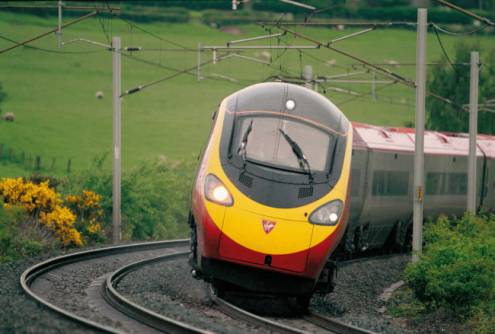
Facing
points
UK rail
Scotland is reached by two principle railway lines, the East Coast and the West Coast Main Lines. Both are electrified, but the track of the West Coast Main Line (WCML) has recently been upgraded to allow faster trains.
To attain a train speed of 270 kph (168 mph) in an attempt to rival the French TGV (train à grande vitesse), while keeping to the rails on bends, a minimum track radius of 4000 metres is required. This has been provided by the route of the Channel Tunnel Rail Link (CTRL) which connects the London St Pancras station, with the UK side of the tunnel. The speed of 225 kph (140 mph) desired for the WCML required a minimum radius of 2800 metres which proved impossible to achieve by track re-alignment for the deployment of conventional trains. The normal "banking" of the track, in which the outside rail is higher than the inside rail on bends, allows the centrifugal force and gravitational force to combine to produce equal forces on the two tracks and avoids the inside wheels lifting off the rail.
The problem of the tight curves of the WCML was 'solved' by the introduction of the Pendolino version of the tilting train. By tilting inwards by an angle determined by an on-board computer, the system compensates for tight curves without the need for an otherwise excessive banking of the track. The tilting brings the centre of gravity inwards towards the centre of the curve so that the resolution of the two forces is straight down on to the track and the wheels stay in contact with the rails.
In the event the introduction of the desired speed of 225 kph (140 mph) was postponed after tilting trials and is currently restricted to 200 kph (125 mph).

The centrifugal force when negotiating curves is proportional to the square of the speed and inversely to the radius, converted by a combination of banking and tilting which, with the shift inwards of the gravitational force, produces forces in the wheels perpendicular to the track and directly on the rails. Although stability is obtained on tight curves, the load on the track is increased, being a function of the increased centrifugal force plus the normal gravitational force. So renovating the WCML to take tilting high-speed trains has added additional stress to the rails on bends resulting in a higher rate of wear and replacement than would have occurred at the original speed.
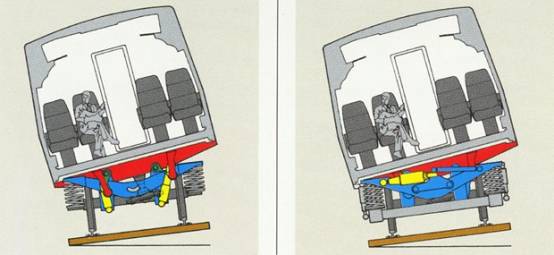
If the combination of the tilt angle, the track banking, the curve radius and the speed of the train is not optimal, the train can leave the track as happened in Queensland in November 2004, when a tilting train was going too fast.
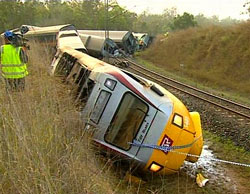
Facing
points.
A set of "facing" points are where, as viewed from the driver's
window, there are two potential routes, one straight, the "main", and
one curved, the "branch". They are used to divert the train to another
track which it enters by means of a matching set of "trailing" points.
A train approaching from the other direction on the opposite track encounters
the other set of points in the pair, which to it is "facing".
Trailing
points are far safer - if they are left in the wrong position, the flanges on
the wheels of the train push the point blades to their correct position and the
train stays on the track. Facing points, if set to divert the train and if
approached with speed, would lead to a derailment.
The use of facing points should be avoided on a track carrying high-speed
traffic.
Trailing connections are safer, but to use them to run on the opposite track
when the normal track is closed for maintenance, trains have to stop and reverse
which adds to the delays already present with single-line working. (1)
The
facing points below are set to divert. From the opposite direction they would be
trailing points.
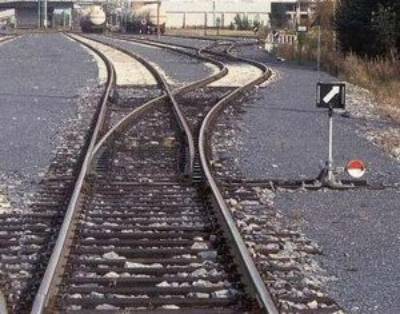
Grayrigg derailment
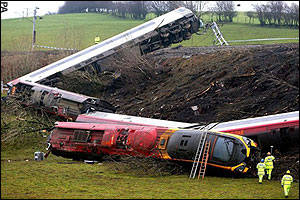
On 23 February 2007 a Virgin Pendolino tilting train on the WCML left the track having encountered what is reported as being a faulty facing point. The "facing" point was paired with a "trailing" point so that either northwards or southwards heading trains could exchange tracks for track maintenance without having to be backed.
The immediate inspection did not rule out the possibility that the points may have been incorrectly set to divert the train, which at the speed it was travelling would have resulted in a derailment.
It has to be asked why there were facing points in a high speed line, when the slightest deficiency risked a derailment? The answer is that the excessive wear on the track means that it must be periodically withdrawn from service for maintenance. The decrease in journey times procured by the increase in speed is subject to an aggregate increase in overall times if the downtime for maintenance is taken into account.
The points remained in place to facilitate single line working when one of the tracks was withdrawn for maintenance, providing in themselves an additional maintenance object.
Because there are few parallel tracks to allow maintenance to take place without interruption of services, an overall reduction in journey times will be offset by more frequent down-time for track maintenance. Regrettably, the WCML upgrading was an expensive, ill-conceived exercise. High speed trains should await the construction of an appropriately aligned track as provided for the CTRL and the TGV in France.
More track
The present track inventory is insufficient to carry the additional traffic imposed on it, which is why maintenance is so expensive - it is wearing out too fast. Over the last few years the usage of the railways in the UK has vastly increased and passengers are forced to stand on most commuter journeys. The current solutions presented of faster and longer trains will simply wear them and the track out faster, leading to more breakdowns of both rolling stock and track. Additional tracks are needed on all the main lines and the increase in reliability and efficiency this would produce far exceeds any gains obtained by faster speeds and longer trains.
Rail vs. Air and Road
It is time to set the railways in their true future context.
The strategy for the air and road transport industry is perplexing. The renewable fuels obligation means that a percentage of biofuels will be added to oil and gas based fuels, but shortage of agricultural land and competition to food producers will restrict their universal application. There are unattainable dreams of pollution-free hydrogen for motive power after oil and gas supplies run down; inappropriate because the hydrogen is produced from natural gas or by electrolysis from fossil fuel generated electricity. Generation of hydrogen directly from a nuclear reactor is another often-quoted remote possibility. The solutions are dressed up in carbon reduction terms to reduce global warming, but it is essentially a move to enable the industries to survive their inevitable decline.
Even at the current level of activity, road traffic would consume more than 3 times all the electricity we generate to produce a hydrogen equivalent. With the end of North Sea gas looming and as the de-commissioning of nuclear power gets under way, electricity will be at a premium and only rail can make use of the limited amount of renewable electricity efficiently.
Jet fuel yield is declining as North Sea crude oil (jet fuel yield 20%) runs down and more is drawn from the Middle East (jet fuel yield 8%), and although refineries can be profiled to adjust for this, more is used in-refinery and the overall depletion accelerates. A certain amount of jet fuel will be produced by gas-to-liquids and coal liquefaction processes, but these are inefficient and demand for gas for its normal uses will take precedence. Cheap flights and possible runway extensions will empty the wells even faster so that the air industry by expanding is hastening its own demise. (2)
As motorways empty, the outside lanes could be converted to rail and tramways while essential services use the remaining fast lanes for expensively fuelled emergency vehicles. Urban tramways could be built to connect towns adjacent to the motorways augmented by rail tracks. This adaptation would provide immediate routes for the additional track needed for rail expansion and this should take priority over the building of new motorways and runways which will soon be made redundant. (3)
The railway industry needs to set out its case as the only economic form of transport remaining after oil and gas run down, making the best use of renewable energy.
Postscript
The roots of the accident go back to 1979 when British Railways introduced the prototype Advanced Passenger Train (APT), which was designed to negotiate the curves of the WCML 20% - 40% faster than conventional trains. By 1983, after some discomfort problems, the train was operating successfully. However, it was decided that it did not suit commercial requirements and it was dropped. (4)
The development of the APT was based on the view that new railway tracks would be difficult to justify and that some means must be found to speed up the trains on the WCML. The development of the tilting train continued in Italy, resulting in the Pendolino, which is now deployed by Virgin Trains, one of which sadly was derailed by facing points at Grayrigg.

So the Grayrigg accident followed an historical view that shortened journey times were needed on main lines, but that in spite of the rising use of the railways, an expansion of track could be avoided by the use of the tilting train. The WCML track was upgraded, but for ease of maintenance, facing points were retained. Vast sums were expended on this upgrade to cater for the increased speeds safely, but the removal of facing points was omitted. Maybe an inquiry will recommend that they be removed.
In retrospect, a comparison with the tracks provided for the French TGV, whereby curve radii are long enough to enable high speeds without tilting, would indicate that a similar policy would have provided a more economic solution. In any case, the speed adopted, restricted to 200 kph (125 mph), failed to match its target of 225 kph (140 mph).
Passengers throughout the UK rail system suffer from overcrowded trains and schedules are continually broken by excessive wear and downtime on over-utilised track. The goal was wrongly assumed; reliability and comfort should have been the target rather than speed. The extra time taken in comparison with air travel allows reading and the business use of laptops, but not when standing.
The government has not been inhibited by environmental concerns over new road building and the impact of additional rail track would have been less problematic. The need in the UK is to provide better short commuter services and this should precede initiatives to introduce a high speed network as in France.
The traffic congestion on the motorways is a temporary phenomenon; once abandoned fuel-less vehicles have been removed the under-utilised lanes will allow the overlaying of rail and tram tracks. This would provide a more appropriate solution for UK needs and would provide for goods transport currently carried on the roads.
The Department of Transport needs to come to terms with the reality of peak oil and forget about road charging; by the time it is applied it will not be necessary, but by then the time for new rail track will have passed.
© John Busby 22 March 2007
References:
1) Railway Group Standard - Requirements for the design, operation and maintenance of points
http:// www.rgsonline.co.uk/docushare/dsweb/Get/Rail-33255/GIRT7004.pdf
2) Flight-path Britain – See the Real Energy Review
3) The Busby Report http://www.after-oil.co.uk/transport.htm
4) The Advanced Passenger Train http://www.apt-p.com/aptindex.htm